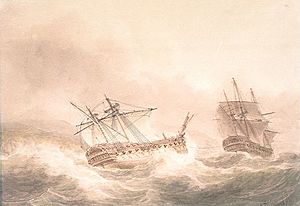HMS Alexander (1778) facts for kids

The launch of HMS Alexander in 1778. She's the ship still on the slipway (the ramp where ships are built), in the middle background.
|
|
Quick facts for kids History |
|
|---|---|
| Name | HMS Alexander |
| Ordered | 21 July 1773 |
| Builder | Deptford Dockyard |
| Laid down | 6 April 1774 |
| Launched | 8 October 1778 |
| Captured | 6 November 1794, by French Navy |
| Name | Alexandre |
| Acquired | 6 November 1794 |
| Captured | 22 June 1795, by Royal Navy |
| Name | HMS Alexander |
| Acquired | 22 June 1795 |
| Honours and awards |
|
| Fate | Broken up, 1819 |
| General characteristics | |
| Class and type | Alfred-class ship of the line |
| Type | Third rate |
| Tons burthen | 1621 (bm) |
| Length | 169 ft (52 m) (gundeck) |
| Beam | 47 ft 2 in (14.38 m) |
| Depth of hold | 20 ft (6.1 m) |
| Propulsion | Sails |
| Sail plan | Full-rigged ship |
| Armament |
|
HMS Alexander was a large warship with 74 guns, part of the Royal Navy. She was built at Deptford Dockyard and launched on October 8, 1778. During her time at sea, she was captured by the French navy, but then the British took her back. She played a role in the famous Battle of the Nile in 1798. The ship was named after Alexander the Great, a famous ancient king. She was eventually taken apart in 1819.
British Service and Capture
On March 13, 1780, Alexander and another British ship, HMS Courageaux, chased a French privateer (a privately owned warship) called Monsieur. After a long chase and some fighting, they captured the 40-gun French ship. The Royal Navy then used Monsieur as one of their own ships.
In 1794, Alexander was sailing back to England with HMS Canada. They had just finished escorting a group of merchant ships to Spain. Suddenly, they met a French group of warships. This French group had five large 74-gun ships and three smaller frigates.
During the battle on November 6, 1794, the French ship Droits de l'Homme attacked Alexander. Alexander managed to damage the French ship's sails and ropes, allowing her to escape for a moment. But then, another French ship, Marat, caught up. She fired at Alexanders back end, causing a lot of damage. After that, the 74-gun ship Jean Bart came very close and fired many broadsides (all guns on one side firing at once). This forced Alexanders commander, Rear-Admiral Richard Rodney Bligh, to surrender his ship. Meanwhile, Canada managed to get away. Later, a special naval court cleared Admiral Bligh of any blame for losing his ship.
The French took Alexander to their port in Brest and renamed her Alexandre. On June 22, 1795, she was part of a French fleet near Belle Île. The British Channel Fleet, led by Lord Bridport, found them. The British ships chased the French fleet and fought them in the Battle of Groix. During this battle, two British ships, HMS Sans Pareil and HMS Colossus, recaptured Alexander. After the battle, another British ship, HMS Révolutionnaire, towed Alexander back to Plymouth.
Return to British Service
In 1798, Admiral Nelson was sent to the Mediterranean Sea with a group of ships, including Alexander. They sailed from Gibraltar on May 9. On May 12, a strong storm hit them in the Gulf of Lion. The storm broke the top parts of Vanguard's masts. Alexander then took Vanguard in tow (pulled her along) to help her reach Sardinia.
Alexander took part in the famous Battle of the Nile in 1798. Captain Alexander Ball was her commander. The battle started on the evening of August 1, 1798, about half an hour before sunset. Alexander was the second ship to fire at the French fleet. She attacked the French flagship, L'Orient. Alexander helped sink three French ships before she had to pull back because of a small fire on board. Alexander was one of the few ships in the battle that did not have soldiers on board.
Alexander also shared in the money from capturing a French ship called Vengeance. This ship was captured near Valletta, Malta, on August 6.
Alexander was part of the navy's campaign in Egypt between March 8 and September 2, 1801. Because of this service, her officers and crew were given a special medal called the Naval General Service Medal in 1847. It had a clasp (a bar on the ribbon) that said "Egypt."
Fate of the Ship
From 1803, Alexander was not actively used and stayed in Plymouth. She was finally taken apart in 1819, ending her long service.
Images for kids
-
Launch of HMS Alexander at Deptford in 1778 (BHC1875), by John Cleveley the Younger (NMM) - HMS Alexander is the ship still on the slipway, centre background




